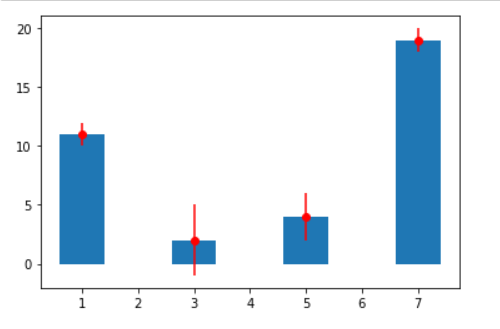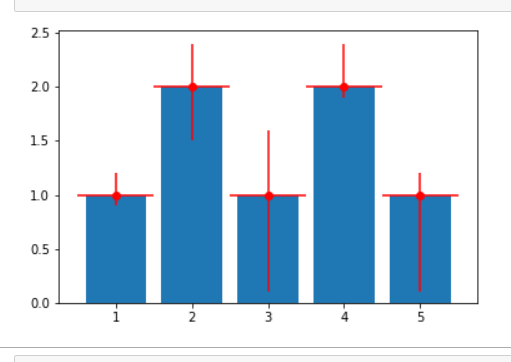将误差线添加到 Matplotlib 条形图
先决条件: Matplotlib
在本文中,我们将使用 Matplotlib 创建带有误差线的条形图。误差条形图是表示数据可变性的好方法。它可以应用于图形以提供有关所呈现数据的详细信息的附加层。
方法:
- 导入所需的Python库。
- 制作简单的数据。
- 使用 plt.errorbar()函数绘图
- 显示图表
错误栏( ) matplotlib 库的 pyplot 模块中的函数用于将 y 与 x 绘制为带有附加误差条的线条和/或标记。
Syntax: matplotlib.pyplot.errorbar(x, y, yerr=None, xerr=None, fmt=”, ecolor=None, elinewidth=None, capsize=None, barsabove=False, lolims=False, uplims=False, xlolims=False, xuplims=False, errorevery=1, capthick=None, \*, data=None, \*\*kwargs)
Parameters: This method accept the following parameters that are described below:
- x, y: These parameters are the horizontal and vertical coordinates of the data points.
- ecolor: This parameter is an optional parameter. And it is the color of the errorbar lines with default value NONE.
- elinewidth: This parameter is also an optional parameter. And it is the linewidth of the errorbar lines with default value NONE.
- capsize: This parameter is also an optional parameter. And it is the length of the error bar caps in points with default value NONE.
- barsabove: This parameter is also an optional parameter. It contains boolean value True for plotting errorsbars above the plot symbols.Its default value is False.
下面给出使用上述方法的实现:
示例 1:在“y”值中添加一些错误。
Python3
# importing matplotlib
import matplotlib.pyplot as plt
# making a simple plot
a = [1, 3, 5, 7]
b = [11, 2, 4, 19]
# Plot scatter here
plt.bar(a, b)
c = [1, 3, 2, 1]
plt.errorbar(a, b, yerr=c, fmt="o", color="r")
plt.show()Python3
# importing matplotlib
import matplotlib.pyplot as plt
# making a simple plot
a = [1, 3, 5, 7]
b = [11, 2, 4, 19]
# Plot scatter here
plt.bar(a, b)
c = [1, 3, 2, 1]
plt.errorbar(a, b, xerr=c, fmt="o", color="r")
plt.show()Python3
import matplotlib.pyplot as plt
a = [1, 3, 5, 7]
b = [11, 2, 4, 19]
plt.bar(a, b)
c = [1, 3, 2, 1]
d = [1, 3, 2, 1]
plt.errorbar(a, b, xerr=c, yerr=d, fmt="o", color="r")
plt.show()Python3
# importing matplotlib
import matplotlib.pyplot as plt
# making a simple plot
x = [1, 2, 3, 4, 5]
y = [1, 2, 1, 2, 1]
# creating error
y_errormin = [0.1, 0.5, 0.9, 0.1, 0.9]
y_errormax = [0.2, 0.4, 0.6, 0.4, 0.2]
x_error = 0.5
y_error = [y_errormin, y_errormax]
# ploting graph
plt.bar(x, y)
plt.errorbar(x, y,
yerr=y_error,
xerr=x_error,
fmt='o', color="r") # you can use color ="r" for red or skip to default as blue
plt.show()输出:

示例 2:在“x”值中添加一些错误。
蟒蛇3
# importing matplotlib
import matplotlib.pyplot as plt
# making a simple plot
a = [1, 3, 5, 7]
b = [11, 2, 4, 19]
# Plot scatter here
plt.bar(a, b)
c = [1, 3, 2, 1]
plt.errorbar(a, b, xerr=c, fmt="o", color="r")
plt.show()
输出:

示例 3:在 x 和 y 中添加错误
蟒蛇3
import matplotlib.pyplot as plt
a = [1, 3, 5, 7]
b = [11, 2, 4, 19]
plt.bar(a, b)
c = [1, 3, 2, 1]
d = [1, 3, 2, 1]
plt.errorbar(a, b, xerr=c, yerr=d, fmt="o", color="r")
plt.show()
输出:

示例 4:在 x 和 y 中添加变量误差。
蟒蛇3
# importing matplotlib
import matplotlib.pyplot as plt
# making a simple plot
x = [1, 2, 3, 4, 5]
y = [1, 2, 1, 2, 1]
# creating error
y_errormin = [0.1, 0.5, 0.9, 0.1, 0.9]
y_errormax = [0.2, 0.4, 0.6, 0.4, 0.2]
x_error = 0.5
y_error = [y_errormin, y_errormax]
# ploting graph
plt.bar(x, y)
plt.errorbar(x, y,
yerr=y_error,
xerr=x_error,
fmt='o', color="r") # you can use color ="r" for red or skip to default as blue
plt.show()
输出:
